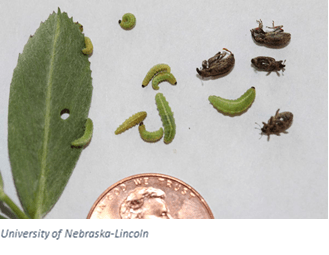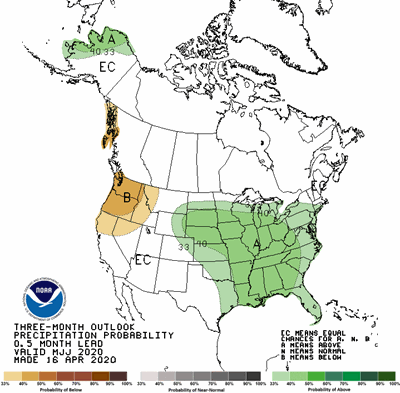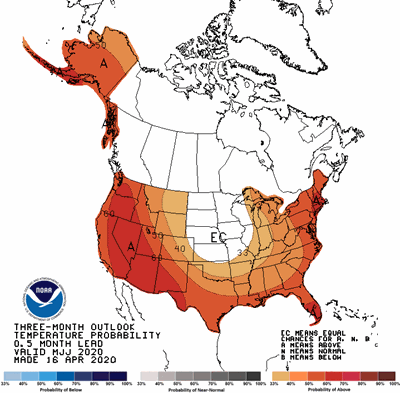Agronomy Update: Observations From The Field
BY DAIRYLAND SEED AGRONOMY TEAM
Insect Trap Counts Have Been High, Recently
Insect pheromone traps are indicating heavy migration of true armyworm and black cutworm adults into the Midwest. They have hitched a ride from the southern states riding on weather systems and getting dumped off to begin their life cycle in the Midwest. However, we are not too alarmed at this time due to the recent cold snap. But when weather warms, they resume their mission with new flights from the south. Trapping in the southern most area (thanks to Purdue University and our very own, Dan Ritter of the Dairyland Seed footprint) is an aid in determining the potential of insect activity in northern and eastern areas in the near future. Many fields did not receive a fall herbicide or a spring burndown yet, therefore, providing plenty of egg laying sites. I have seen a lot of chickweed on many fields!
Migrating black cutworm moths are attracted to fields with significant coverage of winter annuals, particularly broadleaf weeds such as chickweed. Moths lay the eggs on these weeds in the spring. Fields with an infestation of chickweed should plan on planting insect traited corn that controls black cutworm or scout fields regularly through V6 for black cutworm damage. Their favorite weed for egg laying is chickweed and there is plenty of that around this year. Black cutworms could be a problem in both corn and soybeans if weeds are burned down after egg laying and the only meal available is corn or soybeans after they hatch.
True armyworm adults will lay eggs in small grains including cereal rye cover crop. Corn planted into rye cover crop should be scouted regularly for true armyworm feeding. In addition, any corn planted next to rye or wheat should be scouted for true armyworm feeding as the wheat or rye matures. True armyworm will leave maturing wheat or rye and migrate to neighboring corn fields. True armyworm infestations may consume a lot of corn very quickly -- scouting is essential. Meanwhile wheat must be scouted for true armyworm feeding. True armyworm may cause heavy economic damage to wheat also.
With high trap counts and some weedy fields, we think it will be likely for susceptible fields to see infestations of these pests somewhere. Scout!
Give us a call as you get the planters rolling. Stay safe this spring.
The Evil WeeviL

Timing: The lifecycle results in larval feeding during first crop and early in second crop, rarely do issues show up in third or fourth crop.The Evil Weevil: We can almost sympathize with the creature for having a name that is so conducive of such iteration. But the truth is hard to deny. The Alfalfa Weevil is starting to show up in parts of the Midwest on first crop alfalfa. Local hotspots are popping up in Indiana and could move north. Stay tuned for further updates from the Dairyland Seed Agronomy Team. In the meantime, here is the 101 of the Alfalfa Weevil.
- Identification: The pale-green larvae have black heads and tend to feed on the young growth of the plants. Adults are gray beetles.
- Control measures: The University of Wisconsin recommends control when 40% of first crop plants show signs of feeding (not to be confused with 40% defoliation). If harvest is more than 10 days out, spray with insecticide. If the normal cutting schedule puts harvest at less than 10 days, go cut immediately. Early harvest will save an insecticide application. In this scenario, watch second crop regrowth carefully for continued feeding. If weevils are present and regrowth does not start 3-4 days after cutting, spray with an insecticide immediately.
Observations From Our Neighborhood for the Optimist in You!
During our weekly Monday morning Agronomy Team conference call, there seemed to be a very strong sentiment that the start to 2020 planting was developing at a far more promising clip than the previous year. As each of our five Regional Agronomists gave their thoughts and observations to date, a sense of relief and hope for growers able to pull the trigger in both corn and soybeans in most geographies within the Dairyland Seed footprint was palpable. In fact, most reported that that grower spirit and outlook are certainly more promising at this point in the game than in 2019.
Upon opening Monday afternoons USDA Crop Progress report, proof of this realization came in the form of incredible stats compared to this time last year! Actually, the USDA data shows that six of the seven states we do business in is moderately to significantly ahead of the curve as compared to the five-year average. Hopefully, this incredible start and a fairly favorable three-month weather outlook will put us in position to tackle the remainder to of this growing season with gusto. Stay healthy, safe, and positive!!
 |
 |
Crop Progress: Released May 4, 2020, by the National Agricultural Statistics Service (NASS), Agricultural Statistics Board, United States Department of Agriculture (USDA).
|
State/Crop |
May 3, 2019 |
April 26, 2020 |
May 3, 2020 |
2015-2019 Average |
|
Illinois Corn |
10 |
37 |
56 |
54 |
|
Illinois Beans |
3 |
18 |
31 |
12 |
|
Indiana Corn |
3 |
18 |
33 |
26 |
|
Indiana Beans |
1 |
11 |
22 |
9 |
|
Michigan Corn |
3 |
3 |
11 |
12 |
|
Michigan Beans |
2 |
4 |
13 |
4 |
|
Minnesota Corn |
5 |
40 |
76 |
36 |
|
Minnesota Beans |
0 |
5 |
35 |
10 |
|
North Dakota Corn |
2 |
0 |
4 |
19 |
|
North Dakota Beans |
1 |
0 |
1 |
5 |
|
South Dakota Corn |
0 |
8 |
38 |
18 |
|
South Dakota Beans |
0 |
1 |
11 |
3 |
|
Wisconsin Corn |
6 |
11 |
33 |
20 |
|
Wisconsin Beans |
1 |
2 |
14 |
3 |
Corteva Technology Use Agreements
All growers with orders for any Corteva Agriscience brand seed product, regardless of crop or trait (including non-GM products) need to have a signed Corteva Technology Use Agreement in place by September 1. Growers should sign the Corteva Technology Use Agreement electronically at www.agcelerate.com. Signing electronically is preferable, however, paper copies are available at www.traitstewardship.com.
 |
 |
 |
 |
 |
| Brian Weller Western Region 507.456.3034 |
Dan Ritter Central Region 219.863.0583 |
Branden Furseth Northern Region 608.513.4265 |
Rod King Eastern Region 574.596.6721 |
Terry Jones Eastern Region 419.630.3115 |
